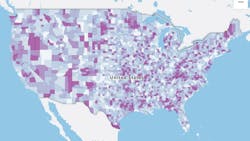COVID Community Vulnerability Map Helps Allocate Resources
A new tool has become available that enables healthcare providers and communities battling the COVID pandemic to identify the social determinants of health (SDOH) that put populations at greater risk, informing community planning and resource allocation to proactively mitigate the risk to vulnerable populations.
The tool, COVID Community Vulnerability Map, was produced by Jvion, a provider of clinic AI, which is built on Microsoft Azure maps.
The interactive map identifies populations down to the census block level that are at risk for severe outcomes upon contracting a virus like COVID. Severe outcomes include hospitalization, organ failure and mortality.
Additionally, the map surfaces the socioeconomic and environmental factors, such as lack of access to transportation or nutritious food, that put patients at greater risk. The map is also overlaid with points of interest, such as hospitals, food sources and transportation, in relation to the at-risk communities.
These insights can help inform providers, public health organizations and community support agencies as they look to deploy interventions, outreach and other services to keep individuals from contracting the virus and, once infected, manage their care towards a positive outcome.
With over 10,000 cases in the United States, there is a growing concern that healthcare systems could soon be overwhelmed, underscoring the need for proactive action to ensure the most vulnerable patients have access to care. However, the existing COVID case data is retrospective and incomplete, minimizing the value for public health officials, healthcare providers and other community organizations hoping to stem the outbreak and prioritize care for the most vulnerable patients.
While there is not yet enough data from the pandemic for a COVID-specific risk calculation, Jvion was able to leverage the de-identified health data of 30 million patients already accounted for in Jvion’s AI core.
Using such a large dataset minimizes the risk of bias. Of this data, Jvion looked at a representative sample to understand the risk drivers for similar viruses that can lead to acute respiratory illness and organ failure, such as influenza. The analysis identified disparities in risk between different patient populations, as well as the socioeconomic and environmental factors driving that risk. These insights have been applied to the COVID Community Vulnerability Map.
The map can quickly help local health departments prioritize their limited resources for response planning and adapt their tactics to the needs of neighborhoods and communities. By understanding the differentiated needs within their population, health systems can more adequately plan for healthcare utilization, deploy preventive or mitigating care resources, and anticipate the short-, mid- and long-term impacts of public health decisions, such as school and business closures.
“We are tremendously grateful for the thousands of healthcare workers on the frontlines of the battle against COVID,” said Shantanu Nigam, Jvion’s CEO, and founder. “Their courage and rapid mobilization in the face of the greatest public health threat of our time has been incredibly inspiring. We are working around the clock to provide them with data-driven insights to help them protect the most vulnerable members of their communities.”
Following the CDC recommendations is critical to preventing exposure and transmission. Social distancing and limiting public activity are the most effective actions that can be taken. Individuals who suspect they may be ill should stay at home and avoid contact with others. Risk can also be mitigated with frequent and thorough hand washing. Touching the face with unwashed hands should be avoided. Frequently touched surfaces should be cleaned and disinfected daily.
